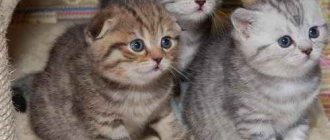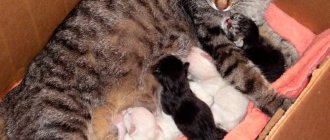Every responsible owner approaches the health of his furry pet with particular seriousness. Understanding that this factor is largely determined by several factors, the owner tries to create the most suitable conditions so that the development of kittens corresponds to all normal indicators. These include proper nutrition, the home conditions in which the animal lives, the presence of other pets in the house, and so on.
Why monitor the development of newborn kittens?
Knowing how a kitten grows and what skills it should acquire by a specific age, you can monitor your own pet. If you notice a deviation from the norm in any indicators in time, it is quite possible to eliminate it in the early stages of the problem.
The stages of growth and development of furry babies, from the moment of birth to one year, are associated with certain patterns. At the same time, each kitten is individual in its own way. Despite the fact that they go through the same stages of growing up, day by day and month by month. But they are all so different that it is impossible not to notice it even among the offspring of the same mother cat.
So, it should be noted that the first three months of a kitten’s life pass quite quickly for him. He is growing up quickly and gaining weight. This period is decisive in its further existence and development. Having overcome a kind of “critical” age threshold, most likely, everything will be fine in the future.
What should owners be wary of?
Care and attention are the most important things kittens need at this age. It is important not to miss the following points in the condition of a kitten up to 3 months:
- does not gain weight well;
- sleeps separately from the nursing cat and the rest of the litter of kittens;
- looks noticeably weaker than them;
- his mother ignores him;
- the kitten often experiences vomiting and diarrhea;
- discharge from the eyes, nose, anus.
If kittens have at least one of the above signs of pathology, they must be urgently shown to a specialist.
Cat pregnancy
The cat is in an interesting position, usually 9 weeks.
But what incredible changes occur inside her (in utero) during this time. Just imagine that in just 2.5 months, from a small zygote cell, you get a small but fully formed kitten, which will very soon begin an independent life.
To better understand what is happening in your cat’s body, we have compiled a handy list describing the changes by week:
- 1 – 2 weeks – In the first days after mating with a cat, it is very difficult to say whether they succeeded or not. During the first seven days, the male's sperm fertilizes the cat's eggs, and then they begin their movement to the uterus, where the kittens will develop in the future. The process of growth and development of kittens begins.
- 3 weeks – The embryo begins to develop organs. At this time, the cat experiences a real surge of hormones, its nipples darken and swell a little. In some cases, during this period the cat begins to develop toxicosis, suffers from nausea, and sometimes even refuses to eat. The size of the kitten during this period is only 25-30 mm. The formation of paws begins. The location of the kitten's ears and eyes has already been determined.
- 4 weeks - During this period, the genitourinary system of the future kitten is formed, the kidneys, bronchi and lungs, pancreas, esophagus, liver and thyroid gland are formed.
- 5 weeks – You can already visually observe a significant increase in the abdomen. At this time, experienced specialists can even determine the number of kittens that the female is bearing. After the 5th week, you need to be very careful when picking up your cat. During this period, the kitten’s nervous system begins its active construction.
- 6 weeks - Small kittens can already be identified in the cat’s stomach; the ribs, fingers, and wrists are saturated with calcium - now these are no longer cartilages, but bones. Teeth begin to form.
- From the 7th to the 9th week, kittens acquire an individual color and external individual characteristics of the breed begin to form.
In such a short period of time, a real miracle happens in the cat’s stomach.
The fact is that due to her large belly, she has poorer balance and there is a very high risk that she may fall or jump unsuccessfully. Take care of our little friends.
READ Instructions for use of Milbemax for kittens
The first days after birth
There is probably no person who does not know that newborn kittens are absolutely defenseless. They are born tiny, like little mice, blind and deaf. The only thing they need in the first weeks is their mother. She is with them almost around the clock, leaving only occasionally to eat and relieve herself. Based on the first two weeks of kitten development, it is difficult to imagine what they will look like as adult animals. Their eyes are almost completely closed, and their tiny ears seem to be neatly folded.
It is worth noting that for a kitten in the first days it is extremely important that the cat be nearby. Thermoregulation in babies is imperfect; their bodies can quickly become hypothermic or, conversely, overheat. Mom helps maintain the optimal temperature in the place where their newly-made family is located.
On the 5th-6th day, the withered umbilical cord of the furry babies falls off. Eating, sleeping and periodically defecating are all they do in their young age. The cat tries to lick each kitten: thus, she cares for the offspring, maintaining hygiene and giving them regular abdominal massages, which helps stimulate sufficient excretion of feces and urine.
Second week of life
At 10 days of age, babies' visual organs begin to open and their first hearing abilities appear. They already confidently respond to sound sources, the most significant of which for them can be called the meowing of a cat. Indeed, by 2 weeks, babies’ eyes are open, but their vision is still difficult to call clear: they see everything blurry and fuzzy.
The further development of kittens can be negatively affected by their separation from their mother at such an early age. In the first weeks after birth, for every baby, a cat is not only care, warmth and protection (including immune protection, with the help of antibodies that they receive in regular portions of colostrum and milk). Separation will also negatively affect the pet’s future relationships with people, other animals, and its learning abilities.
Kittens at three and four weeks of age
By the beginning of the third week, small fluffy balls usually begin to emit the first purr, the picture of the visual field of any kitten becomes definite: visually they will already be able to find their mother. After a week, the development of the organs of hearing and smell ends, and the ears take shape. In addition, kittens at the age of 3-4 weeks take their first hesitant steps and pay attention to their sisters and brothers. At the same time, their baby teeth appear, the incisors emerge first, followed by the canines, premolars and molars.
At 4 weeks, you don’t have to worry about the fact that it’s too early to introduce your young pet to the toilet. It is advisable to take care of the baby and, just in case, purchase a litter tray designed for kittens. They often perceive it either as food or as a toy. Ordinary contents of the litter tray may be harmful to the animal if swallowed (for example, silica gel).
Beginning of the second month of life
In the fifth week, the crumbs become simply unrecognizable. It seems that these “hooligans” have nothing in common with those motionless babies who were located in the nest about a month ago: they already run deftly, improve their sense of balance, can bypass obstacles, sneak up from behind and attack. By this time they are already showing concern for each other.
5 weeks is a turning point in the kitten’s nutritional system. At this age, you can try offering him complementary foods. The ideal supplementary diet (the main one is still cat milk) is canned food for kittens.
Peculiarities of behavior of kittens aged 1.5-2 months
After a couple of weeks, by the middle of the second month of life, they still bear little resemblance to adult lazy cats. Kittens constantly communicate, move actively, run, play, and sharpen their nails. A month and a half is a great time to get your first worm vaccination. If there are potentially dangerous objects in the house within easy reach of animals, it is better to remove them. This is about:
- all kinds of chemicals, detergents;
- first aid kit with medications;
- needles, pins, pushpins;
- electrical outlets;
- poisonous indoor plants, etc.
If the pet, at the request and insistence of the owner, is expected to engage in grooming in the future, then the basics of this area must be taught at 7-8 weeks. You should start with simple procedures, let the baby get used to bathing, combing fur, and cutting nails. Of course, by 2 months his claws have not yet become dangerous to others, like those of an adult animal, so there is no need to really trim them. It is important at an early age to accustom the kitten to the position in which this procedure will then take place.
At 8-9 weeks, all baby teeth are usually in place. With breastfeeding, many owners try to separate the babies and completely switch the kittens to “adult” food. Games and contact with people are especially important for small pets, so it would be better if all family members find at least 15-20 minutes every day to communicate with their pet.
Features of the development of Scottish Folds
It is very important for the owner to understand and know what changes in kittens should occur with age.
If you notice that some indicators do not correspond to the norm, you can quickly influence the situation and show the little kittens to the veterinarian.
The sooner you pay attention to deviations, the greater the chances of helping the kitten grow up healthy.
1st week
Kittens are born completely defenseless, deaf and blind, and all they need is a mother whom they can smell. During the first few days, the cat should be nearby almost all the time, because thermoregulation in kittens is still imperfect and they can become hypothermic very quickly without their mother’s warmth.
After the fifth day of life, their umbilical cord dries out. The mother cat, in turn, must constantly lick her babies, thus giving them a tummy massage, which helps stimulate the intestines.
2nd week
At this age, kittens' eyes open, although their vision is still far from perfect - they still see everything in a blurry form. They begin to respond to sounds, trying to catch their mother's meow.
At this age, they receive the most important thing from a cat with milk - antibodies and form their immunity.
At such an early age, it is unacceptable to separate kittens from a cat, because in this case they will not be able to adapt normally to the outside world and establish coexistence with other animals and people.
3rd – 4th week
The time has come for the kitten to finally develop its visual fields and sharpen its hearing. They begin to make their first purr. Small ears take shape. By the end of the 4th week, baby teeth appear. The incisors are shown first and only then canines and molars are visualized.
The first month of the little meowing lump's life has passed. During this time, he grew noticeably and became wiser. But there is still so much interesting and new in this world for the little creature. Let us further consider the development of a cat month by month.
This cute breed lives on average about 15 years. Only by the second year of life does the pigmentation process in cats of this breed end.
It is believed that a kitten must be weaned from its mother no earlier than two months, while small kittens of other breeds can be weaned from their mother much earlier.
Active kittens of this breed react positively to scratching posts and brushing, which is a mandatory procedure for them. More often than other breeds, they encounter ear disease.
They have a beautiful color and thick fur. Expressive eyes and drooping ears make the face of this animal very cute.
| Age | Skills | Weight |
| 1-2 months | Responds to his nickname Starts to eat independently Tray trained | 600-800 grams |
| 3-4 months | Begins to actively jump high Shows his character Masters the scratching post | 1000-1200 grams |
| six months | The cat goes through puberty | 2000-2500 |
| year | An adult cat lives an independent life | 3500-5000 |
All this data is quite conditional. The weight and size of a cat depends on its breed, diet and heredity. Habits and skills depend on how the owner treats him, whether he teaches obedience, combing, etc.
First week
As everyone knows, kittens are born blind, but it is interesting that they also have no hearing. It begins to appear approximately on the 4th day of its life, but the kitten does not yet hear a clear sound. The umbilical cord completely falls off around the 3rd day.
The approximate weight of a newborn pet is 100 grams, and by the end of this week he will gain the same amount. As already mentioned, a kitten is born and remains blind for 14 days, but this does not prevent it from hearing the smell of mother’s milk, even at a distance of half a meter.
This food will be the most appropriate during the first two months, since mother's milk contains the necessary antibodies, which are so useful for the baby's development.
Second week
Around the end of this week, pets should see the whole wide world for the first time. Although the hearing is already quite developed, it is still difficult for the baby to develop it. Within another half month it will be fully formed and then the kitten will be able to clearly determine where the sound is coming from.
This week the small animal may have a body weight of about 250 grams. Towards the end of the second week, they may try to walk, but it will be even more awkward and funny for them. They will also begin to communicate with their mother and brothers.
During this period, the kitten is very small and weak, so if the owners begin to gradually pet it, then they need to do it very carefully and with the utmost caution so as not to harm the pet.
Third week
This week, the little cat begins to stand on 4 legs and navigate in the distance. But so far she has a hard time doing this, so she often bumps into something and falls. Also, purrs learn to scratch themselves behind the ears, their first teeth appear, which will finish growing by the 2nd month of their life.
During this period, approximately one kitten weighs about 300-350 grams. In the third week, pets want to be a little active, so they will happily play with people, and at the same time they will get used to them. See the table for the kitten's weight at 3 months.
Fourth week
At this time, the kitten should have approximately 26 teeth. By six months, kittens' teeth change from milk teeth to molars. Therefore, you can start feeding babies with food other than milk. During this period, it is possible to prevent worms in each kitten.
During the 4th week, kittens gain about 100 grams more in weight. Also this week they need to be served clean filtered water in shallow bowls. In the future, make sure that water is always available to the animals.
Fifth week
By this stage, the cat is no longer actively caring for her babies, so access to constant milk is reduced, as a result you need to ensure that the kittens have something to eat in bowls.
Pet stores sell special liquid food for a specific month of the cat, you need to purchase exactly this one. Liquid food is easily absorbed by the pet's body, but you should not forget that they should also receive solid food.
For one kitten, 100 grams of food will be enough. This period is naturally the most difficult for both the owners and the kitten. But you need to survive it, so be patient.
Little miracles are already starting to try to wash themselves - this, by the way, is a very important moment in the life of every cat, so make sure that each kitten has started this procedure. This is the time to think about a personal house for your pets. This could be a pillow or specially purchased houses or baskets for animals.
The main thing is that they should not be installed in drafts, passages or under the scorching sun. Give your new residents plenty of time, but remember that quiet time should always be present.
Sixth week
The cat receives less or no milk from its mother, which is why it is necessary to provide it with enough dry food. Pets need to be fed 6 times a day, but little by little, only 40 grams of food per meal is enough for them.
This is a very important period in which you need to monitor the stool of each animal. Since other food enters the body, it is unknown how the gastrointestinal tract will digest it. Therefore, if the stool is abnormal and lasts in this form for 3 days, immediately consult a veterinarian.
Try to pay enough attention to small animals, play with them and caress them - they really need it.
Seventh week
This week you will already notice that males are slightly larger than small females and this is normal. The diet should be the same - 6 times a day. However, from this week onwards, the kitten should only consume special food, and not mother’s milk.
The diet should include both dry food and liquid food. Carefully ensure that the kitten does not have diarrhea, because often without mother's milk, they have problems against this background. If this is observed, do not waste time, but urgently contact a specialist.
Eighth week
If by this week the baby has not been weaned from his mother, then this is the time to do it. After all, the kitten is already quite independent, besides, it has all its teeth and can eat solid food. Sometimes during this period, owners begin to sell or give away their small animals to good hands.
The eighth week is just right to accustom the kittens to all the necessary procedures, since they have already become a little stronger and have become independent. Therefore, inspect the ears and eyes, and clean them if necessary.
Also start combing your pet's fur with a special comb. If an animal is separated from its family, it is best to give the new owners some item or the pet’s favorite toy.
When the kitten comes to your new family, try to disturb it less, let it find out everything around and examine it. It is this way of getting to know the new place of residence that will be less painful for the new resident. Let your little children help him adapt quickly - don’t push him over unnecessary trifles.
Ninth week
Development in kittens after three months of life
After three months of age, it is difficult to notice radically noticeable changes in the development of furry babies. True, they grow intensively for up to six months. From 12 weeks to 6 months, they undergo natural preparation for independent living, acquiring fundamental skills and abilities through constant play.
During this period, a feature of the psychological development of almost sexually mature adult cats is the building of a hierarchy. The determination of the leader and subordinate members of their society, which includes people, is an essential component of the relationship between animals of a given species and other inhabitants of the house. It is not surprising that upon reaching 6 months of age, having grown stronger and gaining sufficient confidence in their own abilities, they test the limits of what is permitted, often challenging the owner.
What's the norm?
Knowing in advance how many kittens will appear, especially if the birth is the first, is not only a matter of convenience, but also safety for the animal. The owner will be able to prepare to provide assistance if a large offspring is expected. In addition, you can find new homes for the kids in advance, and breeders could calculate the benefits from selling club kittens.
The exact number of kittens is difficult to predict. Conclusions can be drawn based on statistics. Usually 4 to 6 kittens are born. But there have been cases of the birth of more than 10 healthy babies.
Fact! In 1970, the cat Antigone gave birth to 19 kittens. And a mother from South Africa named Bluebell has 14, and they all survived.
Breeders sometimes rely on this method of determining the number of offspring: you need to look at how many nipples the cat has. Subtract 2 from the sum. The resulting figure will be an approximate number. This method is certainly not accurate, but can be adopted.
At the physiological level, the offspring depends on how many fertilized eggs attach to the wall of the uterus. Veterinarians advise checking the offspring with an ultrasound machine a week before birth.
Important! You should not feel the belly of a pregnant cat with your hands. On the one hand, this can lead to stress for the expectant mother, and on the other, it can harm the babies.
Young and old cats give birth to fewer kittens, while middle-aged cats give birth to the maximum number. In addition, pets living in comfort have fewer children than domestic ones. Scientists explain this fact by the need to continue the birth in unfavorable conditions in which not all newborns will be able to survive.
If a record number of babies are born, this often leads to high mortality, especially if this happens in street animals. They appear with a very small body weight, and the mother's milk is often not enough to feed everyone.











